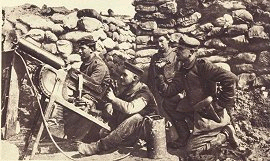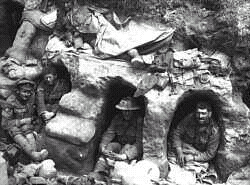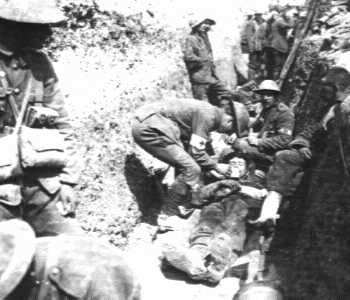
Weapons used during the War
At the start of the First World War many of the soldiers and Generals were prepared for a short open war. The weapons that the services were equipped with reflected this. Rifles and swords were the most common assault weapons provided for the new recruit in 1914: swords mainly for the officers. Pistols and bayonet's were also common pieces of basic weaponry.
As it became evident that the war was not going to be an open conflict new and more deadly weapons were introduced to the battlefield. The Machine Gun of course was paramount in the reasons for trench Warfare occurring in the first place. Alongside this deadly new weapon were other, never seen before methods of killing and maiming.
Gas was used as a weapon, leaving the front line troops reliant upon good fortune and a good gas mask.
The Barrage was developed as a means of attacking. Big Guns were brought in, often from ships, to bombard the trenches of the opposing force. These were complemented by the development of the tank, the aircraft and other weapons such as the Flamethrower.

The Tank
 |
The tank was a brand new idea. early prototypes, such as the one illustrated to the left, were slow, cumbersome and prone to breakdown. Often the soldiers following the tanks into battle would overtake the advancing tank! |
|
|
|
||
Trench Warfare
Trenches were a new phenomenon to both the soldiers and the Generals. many Soldiers had to live, fight and die in these trenches.

The First World War was the first major conflict that made use of what we would consider to be 'modern' weapons. No longer were the Cavalry and the sword the most potent weapons on the battlefield. It was now a case of the machine gun and a gas canister taking control of the battle.
Trenches came about as a
result of the German General Erich von
Falkenhayn ordered his men to dig in to stop
the Allies from advancing any further. Unable to break through this line of
German defenses the British and French had little option but to defend
themselves by digging trenches themselves: otherwise the Germans would have
been able to counter attack with ease.

Trenches were not nice places to live and fight in. They were often waterlogged, and had little if any comforts such as heating and toilets. Much of the time the trenches were as little as 40 meters away from the enemy and the method of attack was to 'go over the top' of the trench and charge at the opposing trench. Millions died as machine guns cut through most soldiers well before they reached the trenches.
|
Aces of the First World War
The pilots of the First World war flew in very flimsy planes with open cockpits. These planes were made from a variety of materials including wood, canvas and several different metals. The design of the airplane, as you can see from the image below, was quite different from the planes that we see nowadays.
During the war a number of technological advances were made. The machine gun was placed at the front of the plane and fired between the propeller blades. Previously a gunner had to sit in the plane and fire to the sides. Alterations also made planes faster and more maneuverable in the air. This led to them being used for some attacks on enemy positions as well as for scouting. Stories about the flying aces of the war, such as the Red Baron, and the history of aviation in the First World War can be read in more detail at the excellent World War One Aviation website. |